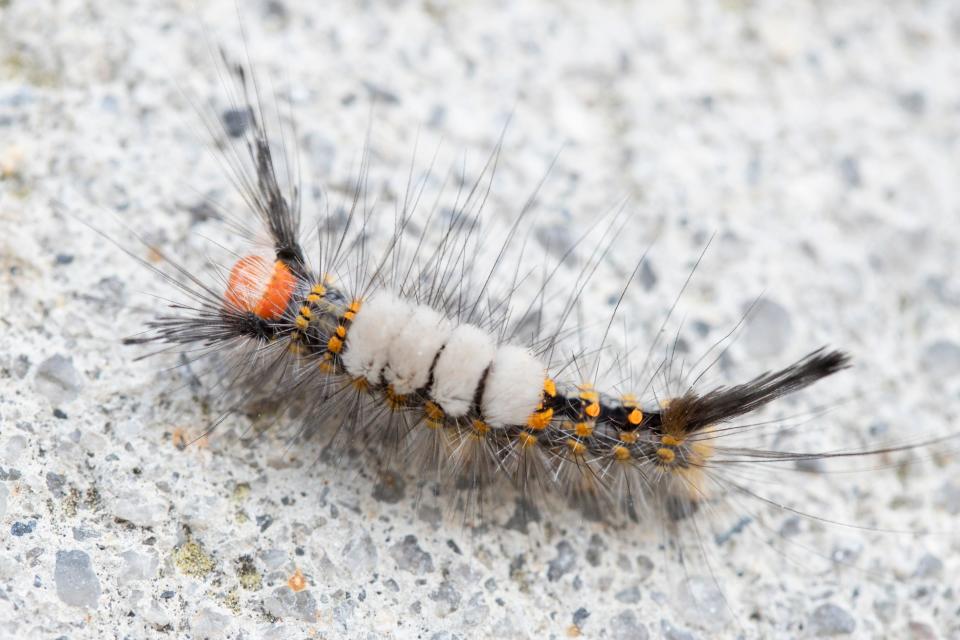What are the fuzzy caterpillars in Florida? Are they venomous?
Is that tiny piece of fuzz moving? Floridians, brace yourself — it's the return of the tussock moth caterpillar.
These hairy critters are lurking around common outdoor hangouts, such as local parks, playgrounds and picnic tables. State health and school officials have put out their annual warning for residents to stay away, as their hair can cause a harmful reaction.
What are tussock moth caterpillars?

According to the Florida Museum of Natural History, the tussock moth caterpillar is a potentially harmful insect with a hairy and colorful body. They are generally dark bodied with a red head, 2 black "hair pencils" projecting forward like antennae, 4 dense tufts of hair (tussocks) on the back, and a fluffy tuft projecting to the rear like a tail.
They hatch from eggs in late February or early March, and by early April, they mature and disperse cocoons. They then feed and grow over a period of 4 to 6 weeks.
Typically dispersed on homes, park benches, and other outside articles, UF experts advise their cocoons are hard to remove.
Are tussock moth caterpillars native to Florida?
![An outbreak of fir tussock moth caterpillars have hit north central Florida. Kayakers, swimmers and scuba divers were aware of them as they stepped on them and tried to avoid them Monday morning, March 28th at the KP Hole Park on the Rainbow River in Dunnellon, FL. The caterpillars were on the walk way and hand rails. The caterpillars can irritate the skin with their hairs which can cause an very itchy rash. They are not poisonous or venomous. [Doug Engle/Ocala Star Banner]2022](https://s.yimg.com/ny/api/res/1.2/G7rvmO6xsNDtuqeNzU53Rw--/YXBwaWQ9aGlnaGxhbmRlcjt3PTk2MDtoPTgwMQ--/https://media.zenfs.com/en/the-florida-times-union/c975b4e82bfb781935bce7034dc3a965)
They are occasionally abundant and widespread throughout northcentral Florida. As per University of Florida's Department of Entomology, there are three species of this insect found throughout the state:
The fir tussock moth - orange-colored spots along the back and sides
The white-marked tussock moth - Lighter body color and yellow spots
The definite tussock moth - yellow or tan head to go with its pale body, hair pencils and tussocks
"Of the three, the fir tussock moth is the most common in Florida, with the white-marked tussock moth following as a close second. The definite tussock moth is very rare," The Museum writes.
Are tussock moth caterpillars poisonous?
They have urticating hairs, known as stinging hairs. While they aren't poisonous or attached to venom glands, their hair can irritate the skin and cause an itchy, burning sensation.
Do tussock moth caterpillars damage plants?
![An outbreak of fir tussock moth caterpillars have hit north central Florida. Kayakers, swimmers and scuba divers were aware of them as they stepped on them and tried to avoid them Monday morning, March 28th at the KP Hole Park on the Rainbow River in Dunnellon, FL. Here one crawls along one of the walkways near the railing. The caterpillars were on the walk way and hand rails. The caterpillars can irritate the skin with their hairs which can cause an very itchy rash. They are not poisonous or venomous. [Doug Engle/Ocala Star Banner]2022](https://s.yimg.com/ny/api/res/1.2/w4EWvajiT0QImg.Mwa73rg--/YXBwaWQ9aGlnaGxhbmRlcjt3PTk2MDtoPTgyMQ--/https://media.zenfs.com/en/the-florida-times-union/31d29335630559ac1c791daec68e8f0c)
According to UF, while the critters do not generally cause significant defoliation or harm to trees, outbreaks of the white-marked tussock moths have "severely defoliated, or removed leaves from trees over large areas in the northern United States and Canada."
What do you do if you get stung by a tussock moth caterpillar?
If you do have an unfortunate encounter with these species, the Cleveland Clinic offers these basic at-home treatment steps to offer relief:
Remove the toxin-laden hairs from your skin. This is best done by using adhesive tape. Gently put the sticky side against your skin on the affected area and lift up, which should pull the hairs out.
Wash the skin thoroughly with soap and water.
Apply an ice pack to reduce swelling and pain.
Create a paste using baking soda and water and slather it on the affected skin to reduce itching. A hydrocortisone cream also may be used.
Take an oral antihistamine (such as Benadryl®) if the reaction to the sting worsens.
Luckily reactions do not last long, generally a day or so.
How do you keep tussock moth caterpillars away from home?
Though these insects are more of a natural nuisance than an environmental challenge to be solved, UF listed two ways for homeowners to manage them if they are causing trouble:
Walk around your house with a broom and sweep the caterpillars into a pail of soapy water.
Wearing a long-sleeved shirt, remove cocoons by slipping tweezers between the cocoon and the wall.
This article originally appeared on Fort Myers News-Press: Tussock moth caterpillars: Are these Florida native insects poisonous?

